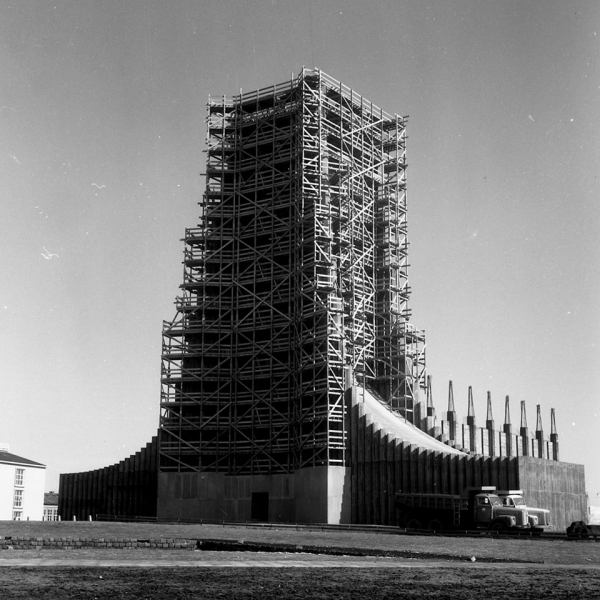Hallgrímskirkja church is probably the best known landmark of Reykjavík. Towering over downtown it stands at 74.5 m (244 ft), making it the tallest building in Reykjavík.
Construction took decades to complete
Hallgrímskirkja was designed by the State Architect of Iceland, Guðjón Samuelsson in 1937, after years of discussion about where to build a church named after and in the honour of Hallgrímur Pétursson, one of the best known poets of Iceland. However, the war delayed the start of construction, which only began in 1945.
Work proceeded slowly, as the church was a monumental undertaking. The crypt beneath the chancel was constructed first, being consecrated in 1948. The steeple and the wings were then consecrated in 1974, while the construction of the nave was only completed in 1986.
Read more: Seven interesting facts about one of Reykjavík’s best known landmarks, Hallgrímskirkja church
As the following pictures show, the construction of the steeple took place without the help of construction cranes. The steeple is hidden inside the wooden scaffolding, built by hand, while the nave stands half built in the background. The photos are taken by local photographer Sveinbjörn Matthíasson in 1965-1969, a few years before the steeple was completed.


This photo, which is most likely taken in 1967 shows the steeple has risen just a little further than in the furst photo. We can also see the nave of the church and the apse at the east end of the nave has not yet been constructed. This photo, from an unknown photographer, was posted by 101Reykjavík.is, which has a huge collection of random historic photos of Reykjavík you can spend hours browsing through, trying to figure out if you recognize any of the houses or sites.

Finally, here is a bonus photo of Reykjavík harbour from Sveinbjörn Matthíasson, taken 1926-28. Most of the modern harbour has yet to be built, allowing us to see what the downtown area looked like shortly after industrialization and the beginning of the modern trawling industry!

Hallgrímskirkja church is probably the best known landmark of Reykjavík. Towering over downtown it stands at 74.5 m (244 ft), making it the tallest building in Reykjavík.
Construction took decades to complete
Hallgrímskirkja was designed by the State Architect of Iceland, Guðjón Samuelsson in 1937, after years of discussion about where to build a church named after and in the honour of Hallgrímur Pétursson, one of the best known poets of Iceland. However, the war delayed the start of construction, which only began in 1945.
Work proceeded slowly, as the church was a monumental undertaking. The crypt beneath the chancel was constructed first, being consecrated in 1948. The steeple and the wings were then consecrated in 1974, while the construction of the nave was only completed in 1986.
Read more: Seven interesting facts about one of Reykjavík’s best known landmarks, Hallgrímskirkja church
As the following pictures show, the construction of the steeple took place without the help of construction cranes. The steeple is hidden inside the wooden scaffolding, built by hand, while the nave stands half built in the background. The photos are taken by local photographer Sveinbjörn Matthíasson in 1965-1969, a few years before the steeple was completed.


This photo, which is most likely taken in 1967 shows the steeple has risen just a little further than in the furst photo. We can also see the nave of the church and the apse at the east end of the nave has not yet been constructed. This photo, from an unknown photographer, was posted by 101Reykjavík.is, which has a huge collection of random historic photos of Reykjavík you can spend hours browsing through, trying to figure out if you recognize any of the houses or sites.

Finally, here is a bonus photo of Reykjavík harbour from Sveinbjörn Matthíasson, taken 1926-28. Most of the modern harbour has yet to be built, allowing us to see what the downtown area looked like shortly after industrialization and the beginning of the modern trawling industry!








